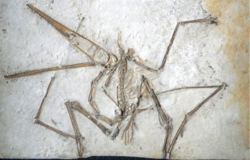Pterosaurs
New taxa
| Taxon | Novelty | Status | Author(s) | Age | Unit | Location | Notes | Images |
|---|---|---|---|---|---|---|---|---|
| Pterodactylus longirostris [2] | Sp. nov. | Jr. synonym | Cuvier | Tithonian | Solnhofen limestone | Junior objective synonym of Ornithocephalus antiquus (now Pterodactylus ) |  |
| |||
|---|---|---|---|
| +... | |||
Paleontology or palaeontology is the study of prehistoric life forms on Earth through the examination of plant and animal fossils . [1] This includes the study of body fossils, tracks ( ichnites ), burrows , cast-off parts, fossilised feces ( coprolites ), palynomorphs and chemical residues . Because humans have encountered fossils for millennia, paleontology has a long history both before and after becoming formalized as a science . This article records significant discoveries and events related to paleontology that occurred or were published in the year 1819.
| Taxon | Novelty | Status | Author(s) | Age | Unit | Location | Notes | Images |
|---|---|---|---|---|---|---|---|---|
| Pterodactylus longirostris [2] | Sp. nov. | Jr. synonym | Cuvier | Tithonian | Solnhofen limestone | Junior objective synonym of Ornithocephalus antiquus (now Pterodactylus ) |  |